Tag: complete collagen
Omega-3 vs Omega-6 Fatty Acids
The typical Western diet tends to present some challenges to our health and wellness. On one hand, it’s high in the food groups that should be kept in moderation, like red meat, processed foods, and high sugar foods. On the other hand, it’s low in the nutrients that we should get lots of, like fiber, water, certain vitamins and minerals, and essential fatty acids. Consequently, this diet style is associated with some negative outcomes if left unchecked, such as increased risk of heart disease, diabetes, obesity, and certain types of cancer. [1]
Of all the nutrients that the Western diet tends to lack, omega-3 fatty acids seem to be among the hardest to get, despite their incredible benefits. This type of essential fatty acid is so important due to its impact on heart health, inflammation, skin health, and more. All the while, it can be incredibly challenging to get from our diet. Well, unless you know where to look for it…
While omega-3 fatty acids can be lacking in the Western diet, omega-6 fatty acids are usually found in abundance. While omega-6 fatty acids do have their benefits, they also have their drawbacks on human health as well. Interestingly enough, the most important factor to consider is the proportion of omega-6 fatty acids you eat in relation to omega-3 fatty acids.
In this blog, I want to help you better understand what exactly the essential fatty acids are, and how they impact our health. I also want to help you identify common sources of these nutrients in the foods you eat, as well as the ideal ratio of omega fatty acids, so you can optimize your diet to support a healthy lifestyle.
Omega-3 Fatty Acids
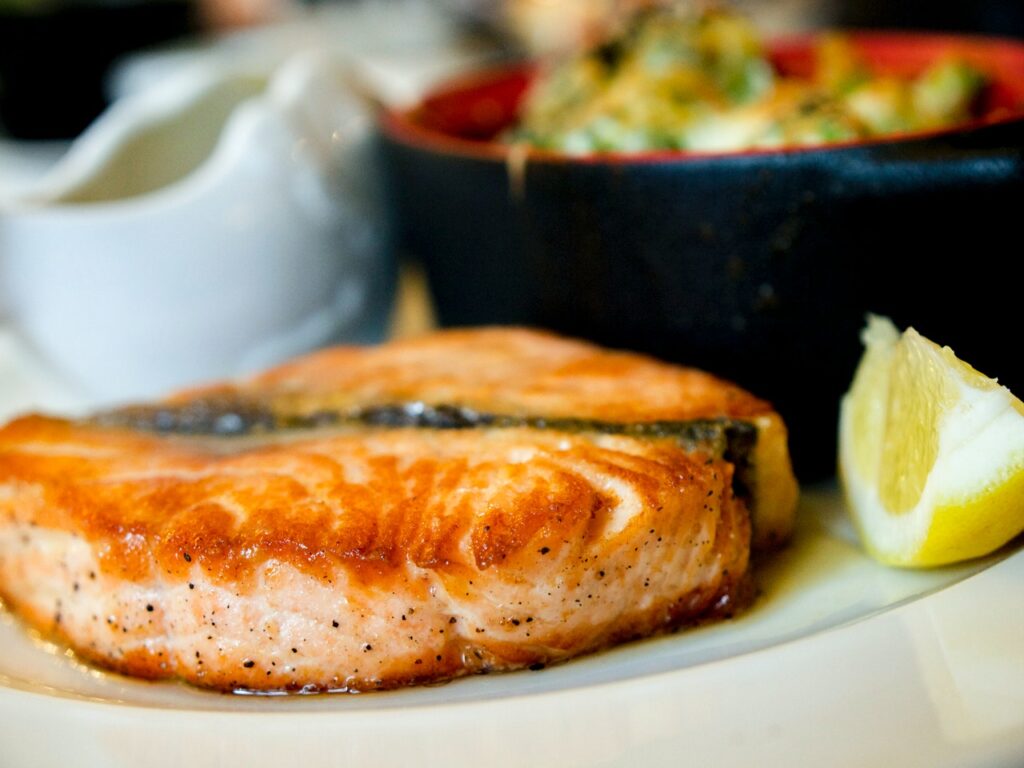
Omega-3 fatty acids are essential fatty acids, meaning that our body cannot produce these nutrients, and we must get them from our diet or supplements to maintain our stores. There are three main types of omega-3s – eicosapentaenoic acid (EPA), docosahexaenoic acid (DHA), and alpha-linolenic (ALA).
They provide us with some incredible benefits, ranging from the health of our eyes, to our brains, to our hearts. Here are some of the most well-established benefits of omega-3s, according to research:
- Consumption of these fats are known to play an important role in heart health. Studies have shown that eating omega-3s is associated with decreased triglycerides, improvement in healthy cholesterol, reduced risk of cardiovascular death, and reduced risk of cardiovascular incidents, like heart attacks. [2-5]
- DHA is an essential component of your eyes, and plays a large role in ocular health. In fact, some studies have found that low intake of omega-3s may cause problems with vision, such as macular degeneration [6-7]
- DHA is also an important component of your brain, especially in the development of the brain. Omega-3s are vital for the development of a fetus, and thus, are often included in prenatal vitamin supplements! [8]
- There have also been studies to suggest that omega-3 fatty acids contribute to decreasing chronic inflammation in the body, as well as anxiety. [9]
You can find EPA and DHA in cold water, fatty fish, such as mackerel, tuna, salmon, herring, and shellfish. You can also find these fatty acids in vegetarian sources, as well. Primarily seaweed, nori, spirulina, and chlorella. ALA is more commonly found in plant-based sources, such as chia seeds, flax seeds, hemp seeds, walnuts, edamame, and kidney beans.
Omega-6 Fatty Acids
Like omega-3 fatty acids, omega-6 fatty acids are essential for our health, and we need to consume them on a regular basis. However, unlike omega-3 fatty acids, omega-6s tend to have some less desirable health effects when eaten in excess.

Most significantly, researchers believe that they contribute to inflammation in the body. While inflammation can be good for us (it’s our body’s way of protecting us from illness and injury), too much inflammation can have some negative consequences. When inflammation persists, the cells and molecules that responded to the initial trigger can actually harm the body tissues they’re trying to protect. This is why we have to consider the amount of omega-6 fatty acids we eat, especially compared to omega-3 fatty acids (which have the opposite effect). [10]
Our diet is much more rich in omega-6 compared to omega-3. You can find omega-6s in a variety of vegetable oils, such as sunflower, safflower, soy, sesame, and corn oils, as well as in seeds and nuts.
The Perfect Ratio for Optimized Health
While omega-6 fatty acids don’t seem to have the overwhelming benefits of omega-3s, together, they are essential for human health. In order to prevent the more negative outcomes associated with omega-6s, it’s important to maintain a healthy ratio of omega-3 to -6 intake.
Currently, the Western diet style averages a ratio of 16:1, omega-6 to omega-3 fatty acids. In comparison, researchers suggest aiming for a ratio closer to 4:1 – i.e. for every 4 mg of omega-6 you consume, you should consume at least 1 mg of omega-3. This ratio would likely improve if the Western diet was richer in consumption of fatty fish, seaweed, algae, seeds, and nuts. However, it can be challenging to maintain consistent intake of these food groups. [11]
The good news is that supplementation is a great way to ensure that you’re getting enough omega-3 fatty acids on a daily basis. One of the more challenging forms of omega-3 to get is DHA, as many individuals may not regularly consume the fish or algae products that are rich in this nutrient.
This is why I choose to formulate Complete Collagen+ with omega-3 fatty acids, DHA fatty acids in particular! I want to make sure that you’re getting all the power of collagen, with the added benefit of a daily dose of omega-3 fatty acids. EverBella’s collagen contains 400 mg of vegan DHA, and was designed to ensure that the collagen is more readily available for absorption.
Try it, risk free with our 180-day, money back guarantee!
Citations
- Tilman, D., Clark, M. Global diets link environmental sustainability and human health. Nature 515, 518–522 (2014). https://doi.org/10.1038/nature13959
- Stone NJ.Fish consumption, fish oil, lipids, and coronary heart disease. Circulation. 1996; 94:2337–2340. CrossrefMedlineGoogle Scholar
- Hu FB, Bronner L, Willett WC, Stampfer MJ, Rexrode KM, Albert CM, Hunter D, Manson JE.Fish and omega-3 fatty acid intake and risk of coronary heart disease in women. JAMA. 2002; 287:1815–1821. CrossrefMedlineGoogle Scholar
- Dietary supplementation with n-3 polyunsaturated fatty acids and vitamin E after myocardial infarction: results of the GISSI-Prevenzione trial. Gruppo Italiano per lo Studio della Sopravvivenza nell’Infarto miocardico.Lancet. 1999; 354:447–455. CrossrefMedlineGoogle Scholar
- Kris-Etherton PM, Harris WS, Appel LJ; American Heart Association. Nutrition Committee. Fish consumption, fish oil, omega-3 fatty acids, and cardiovascular disease. Circulation. 2002; 106:2747–2757. LinkGoogle Scholar
- SanGiovanni, John Paul, and Emily Y Chew. “The role of omega-3 long-chain polyunsaturated fatty acids in health and disease of the retina.” Progress in retinal and eye research vol. 24,1 (2005): 87-138. doi:10.1016/j.preteyeres.2004.06.002
- Merle, Bénédicte M J et al. “Circulating omega-3 Fatty acids and neovascular age-related macular degeneration.” Investigative ophthalmology & visual science vol. 55,3 2010-9. 28 Mar. 2014, doi:10.1167/iovs.14-13916
- Coletta, Jaclyn M et al. “Omega-3 Fatty acids and pregnancy.” Reviews in obstetrics & gynecology vol. 3,4 (2010): 163-71.
- Kiecolt-Glaser, Janice K et al. “Omega-3 supplementation lowers inflammation and anxiety in medical students: a randomized controlled trial.” Brain, behavior, and immunity vol. 25,8 (2011): 1725-34. doi:10.1016/j.bbi.2011.07.229
- Calder, Philip C. “n-3 polyunsaturated fatty acids, inflammation, and inflammatory diseases.” The American journal of clinical nutrition vol. 83,6 Suppl (2006): 1505S-1519S. doi:10.1093/ajcn/83.6.1505S
- A.P. Simopoulos. Evolutionary aspects of diet, the omega-6/omega-3 ratio and genetic variation: nutritional implications for chronic diseases. Biomedicine & Pharmacotherapy, Volume 60, Issue 9, 2006, Pages 502-507, ISSN 0753-3322. https://doi.org/10.1016/j.biopha.2006.07.080
Hydrating Hair Mask
I don’t know about you all, but sometimes my hair gets so dry – especially in the winter time or after I’ve used too much hairspray. So, to ensure I am always keeping my hair happy and healthy, I frequently look for natural ways to hydrate my hair.
While you could break the bank and pay for expensive hydrating hair treatments, I’ve found that there are plenty of ways to treat my hair all while saving my wallet! And not to mention, the DIY products I use are made with natural ingredients (no chemicals or preservatives what-so-ever).
After lots of trial and error, I finally found an amazing DIY hydrating hair mask that leaves my hair feeling AMAZING. It’s super quick to make, and the ingredients are easy to find.
Here’s what you’ll need for this hydrating hair mask…
- 1 ripe avocado
- 1 Tbsp. argan oil
- 1 Tbsp. honey
- 1 tsp. coconut oil, or ⅛ cup coconut milk.
Before we get to the fun part, let’s talk about why these ingredients are going to help your hair feel hydrated and soft.
Avocado
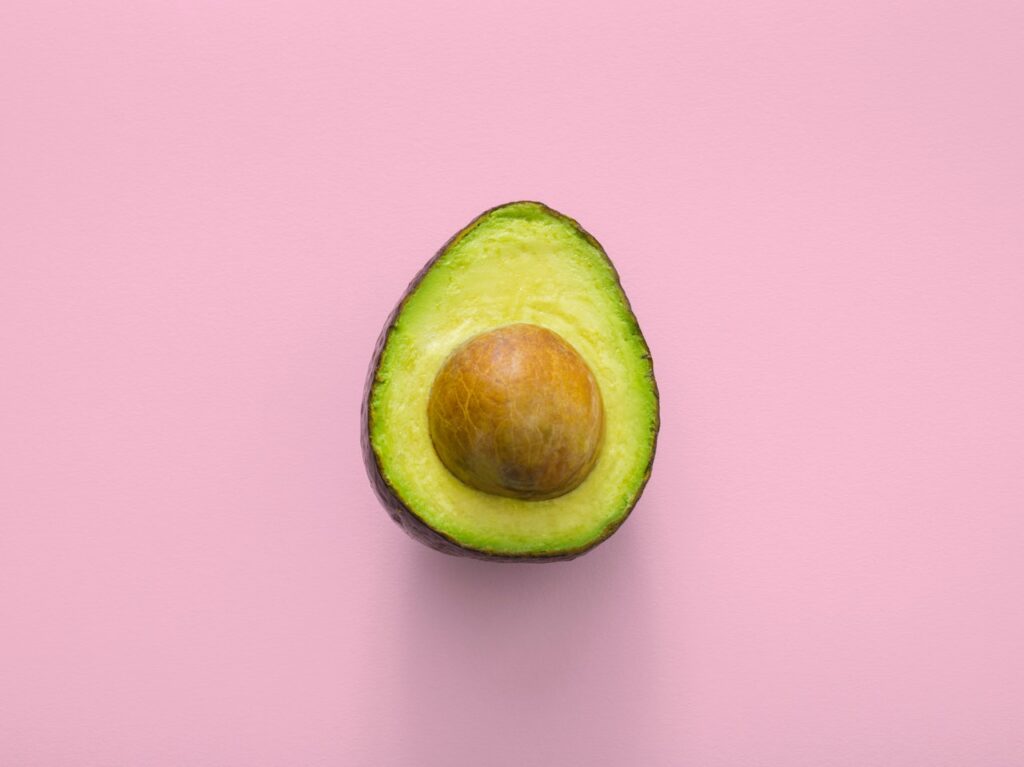
Avocados are rich in the healthy fats, vitamins and minerals needed for healthy hair, such as biotin, vitamin E, magnesium, and potassium. While these nutrients are important for encouraging hair growth, they are also important for maintaining hydration, and preventing breakage.
A study conducted in 2015 found that certain nutrients, such as the magnesium and potassium found in avocados, may be involved in helping seal the hair cuticle. This is important for hydrating your hair because this helps keep moisture in, and prevents further damage of hair strands. Avocado is also considered a humectant, which means that it helps retain moisture, and prevent drying out.
Argan Oil
Argan oil is a popular ingredient in hair and skin products alike. It’s not too surprising considering its amazing hydration properties! Argan oil is chock-full of essential fatty acids and vitamin E, both of which are going to help keep your lovely hair happy and hydrated. The essential fatty acids work to hydrate the hair strands, all while keeping moisture locked in. Meanwhile, vitamin E is going to help prevent your scalp from drying out, which can promote frizz-free, shiny hair.
Honey
Honey really is the star of any DIY beauty product. That’s because it has so many incredible properties to benefit your hair and skin! If you want to learn more about the antimicrobial and anti-inflammatory benefits of honey, you have to check out the Chamomile Face Mask recipe I posted a few weeks ago!
It is thought that honey can help maintain the moisture of the scalp and hair shaft, as well as helping keep it shiny, reducing frizz, and reducing hair breakage. Plus, it makes this mask smell amazing…
Coconut
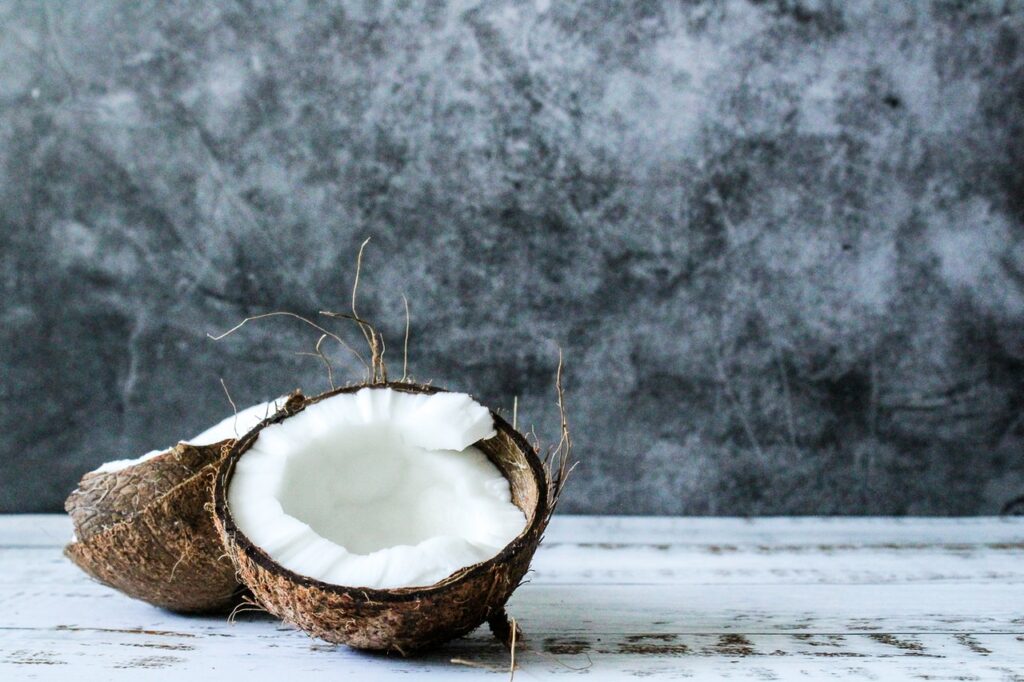
Coconut is rich in something called lauric acid. While lauric acid is one of the components of coconut that can cause elevated cholesterol if you eat too much of it, it adds a lot of benefit to this hair mask. That’s because lauric acid easily soaks into the scalp and hair strands, leaving behind softer, more moisturized, and less frizzy hair.
However, too much coconut oil can make your hair extra oily if you’re not careful. If you have thinner, or oily hair, be cautious of how much coconut you use. Luckily, this recipe doesn’t call for too much coconut, so you should be safe from greasy hair! Now that we’ve established all the wonderful benefits of this mask, let’s get down to business!
Here’s what you need to do…
You can start with either dry or damp hair, whatever you prefer! I chose to start with slightly damp hair (but not totally wet). You’ll want to combine all ingredients together until well blended. Then, work the mask evenly through all your hair, paying special attention to those drier ends! Leave the mask on for 30 minutes, before rinsing off with warm water.

So, there you have it! A quick, easy way to restore your hair’s moisture that will leave you feeling like you just got home from the salon. But, I haven’t even shared the best part yet…Because you will save so much money by avoiding those expensive salon products, you can opt to spend your money elsewhere. And I have the perfect suggestion for where you can spend your savings… You can invest that money back into your hair with Complete Collagen Plus! After years of trying expensive product after product, I realized that I could be doing a whole lot more for my hair by keeping it simple. Give your hair the love and nutrients it needs to thrive with Complete Collagen Plus!
A Halloween Treat to Enjoy: The Benefits of Dark Chocolate!
It’s no secret that I have a major sweet tooth. With Halloween right around the corner, you might think I’d have to hide myself away from all the sweets and candy… But the truth is, I have a great solution for my guilty pleasure. A sweet treat that leaves me feeling satisfied, and pretty happy with my healthy choices – dark chocolate!
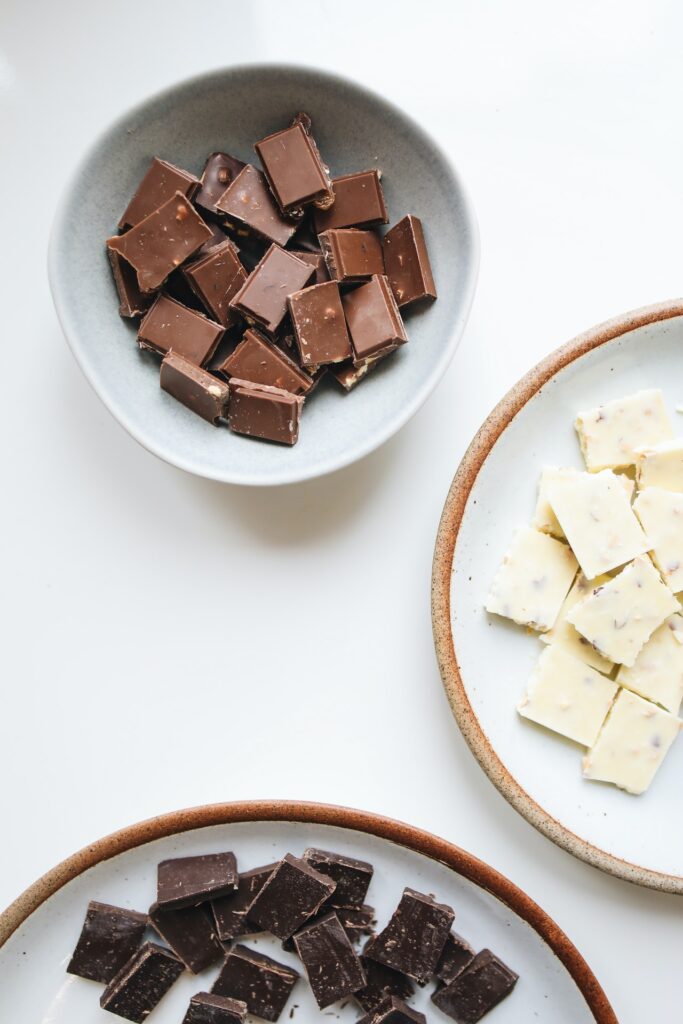
I know that the debate between milk, white, and dark chocolate is hotly contested. But, when it comes down to the actual health benefits of dark chocolate, there is no question on the winner! That’s right, it has some serious health benefits that you don’t want to miss out on. I want to walk you through the pros of choosing dark chocolate, so you know exactly what candy to ‘borrow’ Sunday night from the kiddo’s Halloween baskets.
Fiber and Minerals
Dark chocolate is actually packed densely with nutrients. It seems crazy to think that a dessert is healthy for us, but it’s true! Now, it’s important to note that the real nutrition lies in the cacao seeds that chocolate comes from… Of course, to make it taste as delicious as it is, other ingredients (like sugar) are added. Which is why at minimum, we should aim for 70% dark chocolate or higher. The higher the percentage, the more bitter it may taste, but that’s because we are getting more of the real chocolate, and less of the sugar!
When it comes to the nutrient profile of high percentage dark chocolate, this sweet treat boasts an impressive resume. One bar of dark chocolate (about 100 grams) offers:
- 8 grams of protein
- 11 g of dietary fiber (44% DV)*
- 12 mg of iron (67% DV)
- 230 mg of magnesium (58% DV)
- 311 mg of phosphorus (31% DV)
- 722 mg of potassium (21% DV)
- 3.3 mg of zinc (22% DV)
- 1.8 mg of copper (89% DV)
- 2 mg of manganese (98%) [1]
*% DV means percentage of the Daily Value of a nutrient. This number is based on the needs of an average individual, and is based on a standard 2,000 calorie diet. Depending on the individual, you may need more or less than the % Daily Value, but it can be a helpful reference point!
Of course, you might not eat an entire bar of chocolate in one sitting, but this list is a good representation of how packed full of nutrients that dark chocolate is. It doesn’t stop there either. Keep reading, because it gets even better!
Rich in Antioxidants
Dark chocolate is also rich in antioxidants, particularly flavonols and polyphenols. These are just two of the many types of antioxidants, but they all essentially work the same.
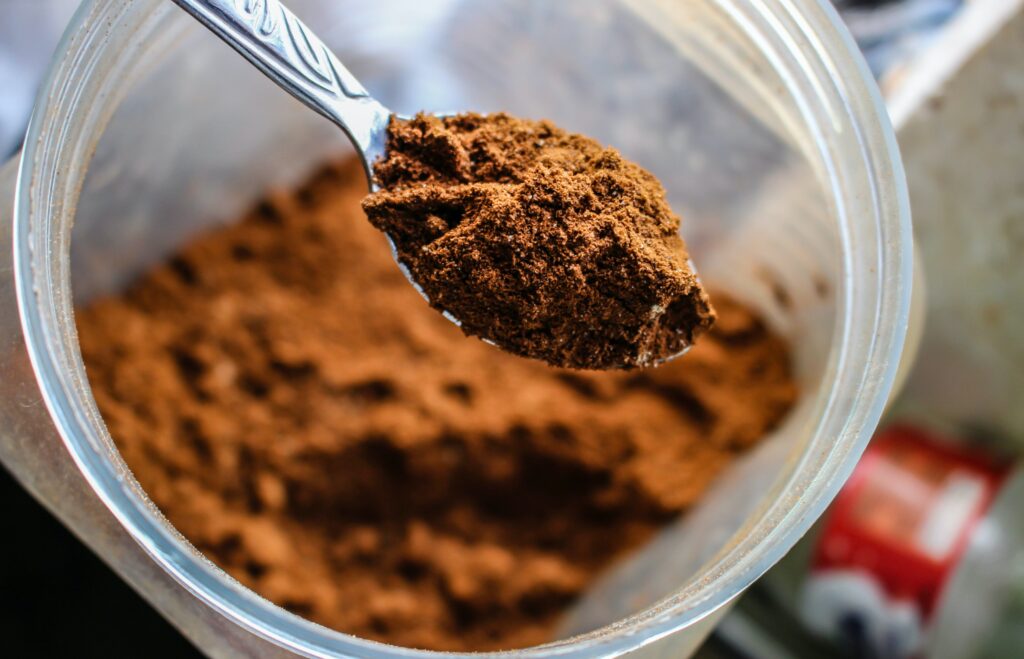
Antioxidants fight against free radicals, and protect the body against oxidative damage. Free radicals are unstable molecules that can damage the healthy cells in our bodies in order to stabilize themselves. We accumulate free radicals from environmental exposure to toxins, such as tobacco smoke and UV light, and also as a natural byproduct of our body’s metabolic processes. Beta-carotene, and other antioxidants, protect against these free radicals by stabilizing and neutralizing them, rendering them benign. [2]
So, dark chocolate can also benefit your health by helping prevent oxidative damage in your body! This is also an important part of why it is also considered to be a heart healthy food. Let’s dig into the research on dark chocolate and heart health next!
Heart Health
Cardiovascular disease is the leading cause of death worldwide, killing nearly 18 million individuals every single year. [3] So, it’s pretty important to minimize our risk of heart disease as much as possible. The good news is that there are many modifiable risk factors that help reduce risk; lifestyle factors, such as diet, exercise, cessation of smoking, and moderating alcohol intake.
So, as you can probably guess, dark chocolate does fall into the ‘diet’ category when it comes to controlling risk factors associated with heart disease. There is actually a good amount of research to indicate that it can benefit our cardiovascular system, for a couple of reasons.
Dark Chocolate & Cholesterol
First, as an antioxidant, dark chocolate is able to limit the oxidation of LDL cholesterol (commonly known as the ‘bad’ cholesterol). Oxidized LDL cholesterol has interacted with free radicals, and can travel through the bloodstream causing damage to the circulatory and cardiovascular systems. As an antioxidant, it can contribute to suppressing the oxidation of LDL cholesterol, and offer protection to these systems.

Next, there has also been evidence to suggest that dark chocolate may contribute to a rise in HDL cholesterol (the ‘good’ cholesterol), and to the decrease in total cholesterol. High levels of cholesterol can contribute coronary artery disease, which means that there is buildup of cholesterol in the arteries that can cause blockages and damage to these vessels. While high LDL cholesterol and total cholesterol may increase your risk of coronary artery disease, HDL cholesterol helps keep the arteries clear, and transports cholesterol back to the liver for excretion. It seems dark chocolate has the ability to improve these clinical markers, which contributes to its heart healthy qualities. [4]
Dark Chocolate & Blood Pressure
Additionally, the flavanols in dark chocolate may be helpful in reducing blood pressure. There have been several studies to show that eating dark chocolate may help lower blood pressure, though the effect is pretty minimal. [5-6] Overall, its do seem to have an effect on overall risk of heart disease. This study found that those who ate a serving of dark chocolate five times per week were significantly less likely to develop heart disease compared to those who ate less dark chocolate, or didn’t eat any at all. [7]
A Healthy, Sweet Option
So, there you have it. If you’ve been looking for some way to make it through this Halloween without breaking your health streak, dark chocolate is the perfect compromise. A couple pieces here and there, and my sweet tooth is fully satisfied. And, I know I’m getting all those benefits that I listed above!
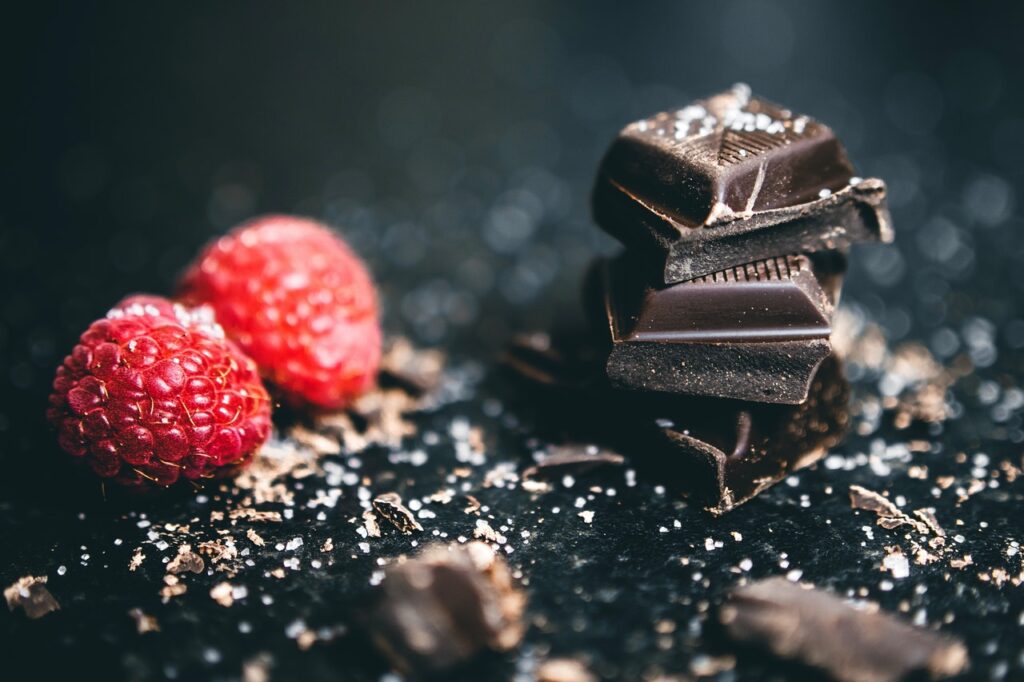
You can eat it plain and snack on a few squares from a chocolate bar, but I love to switch it up every once in a while, too! Here are some of my favorite, healthy treats that get an extra boost from a little dark chocolate.
- Apple + nut butter + dark chocolate chips
- Plain greek yogurt + drizzle of honey + granola + dark chocolate chips
- Strawberries + melted dark chocolate drizzle
- Mixed nuts + dried cranberries + dark chocolate chips
- S’mores – marshmallow + graham cracker + dark chocolate square
- Vanilla frozen yogurt + dark chocolate drizzle + Complete Collagen+ caramel drizzle
Well, to be honest, any of these desserts would be delicious with a drizzle of Complete Collagen+. Trust me, you have to try it! And you can, risk-free for 180 days with our money-back guarantee!
Citations
- Candies, Chocolate, Dark, 70-85% … – Self Nutrition Data. https://nutritiondata.self.com/facts/sweets/10638/2.
- “Understanding Antioxidants.” Harvard Health, 10 Jan. 2019, https://www.health.harvard.edu/staying-healthy/understanding-antioxidants.
- “Cardiovascular Diseases.” World Health Organization, World Health Organization, https://www.who.int/health-topics/cardiovascular-diseases#tab=tab_1.
- Baba, Seigo et al. “Plasma LDL and HDL cholesterol and oxidized LDL concentrations are altered in normo- and hypercholesterolemic humans after intake of different levels of cocoa powder.” The Journal of nutrition vol. 137,6 (2007): 1436-41. doi:10.1093/jn/137.6.1436
- Djoussé, Luc et al. “Chocolate consumption is inversely associated with prevalent coronary heart disease: the National Heart, Lung, and Blood Institute Family Heart Study.” Clinical nutrition (Edinburgh, Scotland) vol. 30,2 (2011): 182-7. doi:10.1016/j.clnu.2010.08.005
- Taubert, Dirk et al. “Effects of low habitual cocoa intake on blood pressure and bioactive nitric oxide: a randomized controlled trial.” JAMA vol. 298,1 (2007): 49-60. doi:10.1001/jama.298.1.49
- Hooper, Lee et al. “Effects of chocolate, cocoa, and flavan-3-ols on cardiovascular health: a systematic review and meta-analysis of randomized trials.” The American journal of clinical nutrition vol. 95,3 (2012): 740-51. doi:10.3945/ajcn.111.023457
